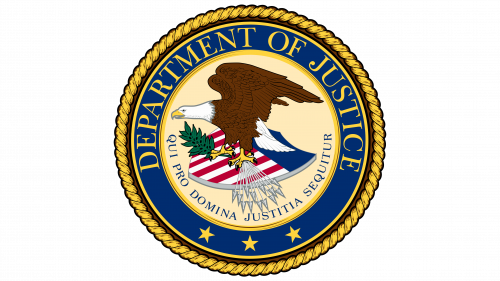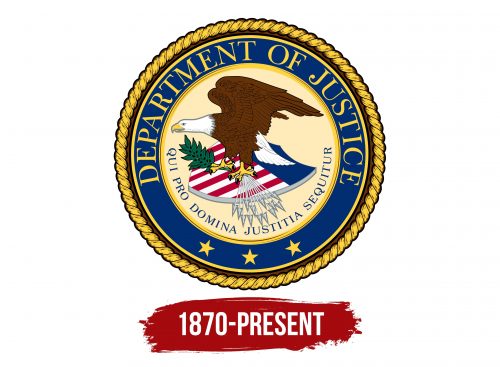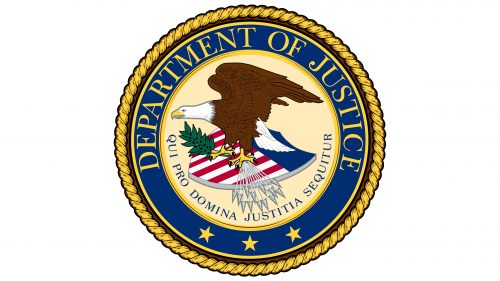 Department of Justice Logo PNG
Department of Justice Logo PNG
The Department of Justice logo embodies honesty, justice, and an unwavering commitment to protecting truth. Every element of the visual symbol conveys strength, determination, and readiness to defend the law and ensure its enforcement. This symbol calls for respect and obedience to the power of the legal system, emphasizing that the principles of justice form the foundation of American society. The emblem demonstrates the power of law and reflects America’s dedication to justice and the rule of law.
Department of Justice: Brand overview
The U.S. Department of Justice (DOJ) has a long history that predates its official establishment in 1870, with its roots going back to the nation’s early years. The office of Attorney General was created by the Judiciary Act of 1789, shortly after the ratification of the U.S. Constitution. President George Washington appointed Edmund Randolph as the first Attorney General. In its early days, the Attorney General served part-time as the federal government’s only legal advisor, often balancing this role with a private law practice.
Over the next few decades, the Attorney General’s responsibilities grew. In 1815, Congress authorized the Attorney General to represent the U.S. government before the Supreme Court. However, before the formation of the modern department, different government departments employed their attorneys, leading to inconsistencies in the federal government’s legal positions.
In 1870, after the Civil War, Congress passed the Act to Establish the Department of Justice. This responded to the need for greater coordination and focus in handling the government’s legal matters. Amos T. Ackerman was appointed the first Attorney General to head the newly created department.
Since its inception, this federal entity has been critical in shaping the U.S. legal system. In the late 19th and early 20th centuries, the department was heavily involved in enforcing antitrust laws, particularly the Sherman Antitrust Act of 1890. This time, high-profile cases against monopolies like Standard Oil and the American Tobacco Company were pursued.
During World War I, the department’s role expanded significantly with the enforcement of the Espionage Act of 1917 and the Sedition Act of 1918, which, though controversial today, increased its prominence.
In the 1920s, the department became deeply involved in combating organized crime, particularly during Prohibition. During this era, the Bureau of Investigation—later renamed the Federal Bureau of Investigation (FBI)—was formed within the department.
During the Great Depression in the 1930s, the entity helped implement President Franklin D. Roosevelt’s New Deal policies by defending new laws against legal challenges in the courts.
World War II brought further responsibilities, including overseeing the internment of Japanese Americans, a decision the U.S. government later apologized for in 1988, acknowledging it was unconstitutional.
In the postwar period, the department became a central player in the civil rights movement. In 1957, the Civil Rights Division was created within the department, and it played a key role in enforcing the landmark civil rights legislation of the 1960s.
The Watergate scandal of the 1970s, which led to President Richard Nixon’s resignation, underscored the importance of maintaining independence from political influence and resulted in the creation of the Office of Special Counsel.
During the 1980s and 1990s, the department focused heavily on fighting organized crime and the war on drugs, passing major laws like the Omnibus Crime Control Act of 1984 and the Crime Control Act of 1994.
After the September 11, 2001, terrorist attacks, its role in national security expanded considerably with the enactment of the Patriot Act, which increased law enforcement powers to combat terrorism.
In the 2000s and 2010s, the agency addressed issues such as voting rights protection, investigating police misconduct, and prosecuting financial crimes following the 2008 financial crisis.
In recent years, the department has faced new challenges, including combating cybercrime, protecting intellectual property in the digital age, and balancing civil liberties with national security.
Throughout its history, this federal body has played a vital role in upholding the rule of law, protecting constitutional rights, and shaping the nation’s legal landscape. From fighting monopolies and defending civil rights to prosecuting terrorists and war criminals, it remains one of the most important and influential institutions in the U.S. government.
Meaning and History
What is Department of Justice?
This department is the primary legal branch of the U.S. government, with broad authority over justice and the enforcement of federal laws. It includes organizations such as the Federal Bureau of Investigation (FBI), the Drug Enforcement Administration (DEA), and the U.S. Marshals Service. Its responsibilities include protecting civil rights, regulating business practices, prosecuting major cases, and combating terrorism. The department is headed by the Attorney General, the president’s legal advisor, and the nation’s chief law enforcement officer. The department often plays a key role in shaping laws and national discussions that impact American society through its activities.
1870 – today
The U.S. Department of Justice logo is a solemn and majestic symbol that has endured for many years, reflecting the country’s law and order stability. The logo’s circular shape emphasizes its official nature, evoking the image of a government seal used to validate important decisions. The golden rope border around the circle symbolizes the value of justice and its unbreakable connection with governmental institutions.
The blue band features the department’s name and three golden stars, representing the importance of the Department of Justice within the nation’s governance system. The image of a bald eagle, a traditional symbol of America, occupies the central part of the logo. The eagle proudly stands on a shield colored in the U.S. flag’s red, white, and blue. The shield symbolizes the protection of the laws and the Constitution, which the Department of Justice is sworn to safeguard. The eagle, symbolic of authority and strength, also signifies the transparency and integrity that are key principles of the department’s work.
Special attention is drawn to the attributes in the eagle’s talons. In one paw, it holds arrows, symbolizing the readiness to defend justice and use force if necessary. In the other talons, olive branches represent the pursuit of peace. This balance between strength and the desire for peaceful solutions is a core principle of the department’s mission.
Below the eagle is the Department of Justice’s Latin motto: “Qui Pro Domina Justitia Sequitur,” which translates to “He who follows justice, rules.” This motto reflects the department’s primary goal of upholding justice in all aspects of its work.
The Department of Justice emblem embodies the seriousness, responsibility, and strength it demonstrates in its work. It remains faithful to the principles of justice and protects the rights of every U.S. citizen.




